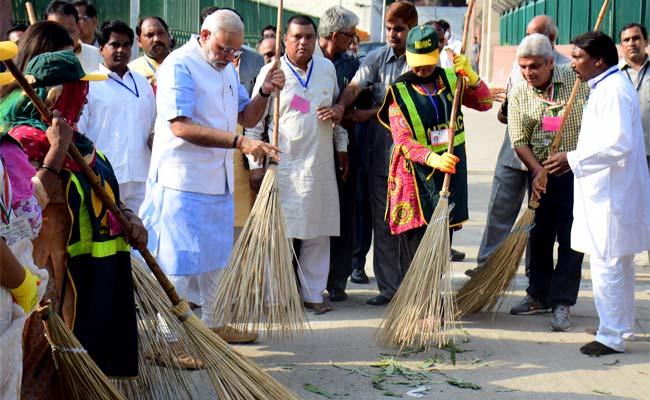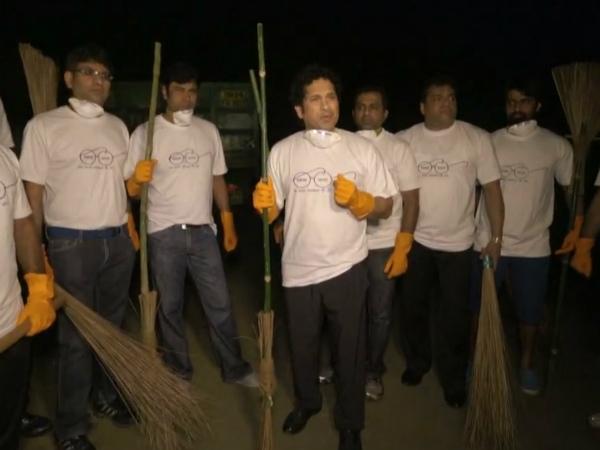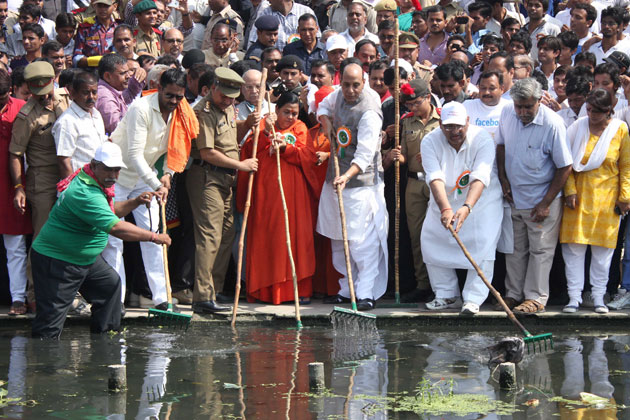SWACHH BHARAT
Mission in Action

Let us fulfill Mahatma Gandhi's unfulfilled dream of clean India.
Prime Minister Narendra Modi's energetic initiative to clean up India is well received by all sections of the society.
To clean India we don't only need brooms but we need a heart to feel, a mind to conceive and a hand to work.
Swach Bharat Cartoon | Swach Bharat Poll | Discussion Forums
Mr. Modi along with his cabinet colleagues and all government employees initiated this as a promotion measure. Prime Minister Narendra Modi cleans the premises of the Mandir Marg Police Station.
Prime Minister Narendra Modi dumps garbage into a bin during the launch of 'Swachh Bharat Abhiyan' in ValmikiBasti.
Clean India was started on Thursday, the 2nd October, giving an auspicious beginning on Gandhi Jayanthi. Though many have their own doubts over this massive mission, it is very essential to start off instead of conducting debates and discussions. Whether we will achieve clean up India mission by 2019, time will answer.
If the garbage is strictly divided as organic or degradable and non degradable, it solves most of the problems in the society. Even if the garbage is not treated properly, it cannot be reused and can lie around as pollution. The most important fact is, unless we discourage plastic we can never achieve SWACHH BHARAT. Also we should always remember, garbage multiplies along with population. The other way of putting it is, garbage multiplied because the population multiplied over the years, may be since Independence.
It is a massive task, which needs planning, organizing, proper collection of garbage, segregation, disposing in the right manner and recycling. An estimate of the urban development ministry in 2009 had put the cost for doing this at about Rs.48,582 crore.
 The other dimension of sanitation is sewage or waste water disposal. CPCB estimates that in 2009, 38 billion liters of sewage was generated per day from 498 tiers I cities. Installed capacity to treat this giant river of waste water is 12 billion litres or less than one-third of the requirement. This means the remaining 26 billion liters is getting dumped into our streams and rivers daily, making many of them terminally sick.
The other dimension of sanitation is sewage or waste water disposal. CPCB estimates that in 2009, 38 billion liters of sewage was generated per day from 498 tiers I cities. Installed capacity to treat this giant river of waste water is 12 billion litres or less than one-third of the requirement. This means the remaining 26 billion liters is getting dumped into our streams and rivers daily, making many of them terminally sick.
Here are some interesting facts collected from various reliable sources. Urban India generates about 47 million tons of solid waste (garbage) every year or about 1.3 lakh tons every day, according to a study by the Central Pollution Control Board (CPCB). But this is only in cities and towns with a municipal bodies and corporations. Another 30% of urban India lives outside these cities. If we add their garbage, the total garbage would amount to about 68 million tons.
In the four metros - Delhi, Mumbai, Chennai and Kolkata - of the 16 billion liters sewage generated per day, only 8 billion liters get treated. In the 410 tier II cities, about 3 billion liters of sewage was generated per day but only a tiny fraction, 0.23 billion liters was treated.
According to a calculation done by TERI in 1998, the garbage generated till 2011 would cover 2,20,000 football fields piled 9 meters (27 feet) high with garbage.
Increasing amount of garbage generation is to be expected as population and Gross Domestic Product (GDP) grew. But here's the thing: nearly one third of the garbage is not collected at all - it is just left to rot away in streets and various other locations. So, in one year, about 14 million tons of garbage is left to rot in urban Indian streets.
The 70% that is collected is taken and dumped either in landfills or just any space available outside the main habitation. Only about 18% of the collected garbage is treated to recycle or make fuel. In other words, about 27 million tons of garbage is collected and dumped out of the city.
 It's not enough if we plan to address the problem of garbage on the streets. We also need to focus on planning hygienic toilets, sewerage treatment plants in order to achieve Swachh Bharat. The urban development ministry had calculated in 2009-10 that it would take Rs. 2.43 lakh crore to build a suitable sewage network covering the whole of urban India.
It's not enough if we plan to address the problem of garbage on the streets. We also need to focus on planning hygienic toilets, sewerage treatment plants in order to achieve Swachh Bharat. The urban development ministry had calculated in 2009-10 that it would take Rs. 2.43 lakh crore to build a suitable sewage network covering the whole of urban India.
About 49% of Indians live in houses with no drains while another 33% live in houses with open drains. Apart from garbage, this is the single biggest source of filth and the primary source of various diseases. The bulk of these people are living in villages which somehow get sidelined in the hype about the need for urban cleanliness.
Clearly, just brooms will not be enough. Building toilets, however laudable a project, will not in itself solve the problem of sewage. Sanitation and hygienic living conditions will need a much larger vision. Prime Minister Modi needs to voice his gigantic plans to move forward with clean and clear thoughts to achieve Clean India by 2019.
Along with Modi's initiative, what if all the Individuals, families at home levels, educational institutions, corporate, private, public sectors and NGO's take up the mission seriously. Yes, instead of posting and feeling that someone is following it, let us all dedicatedly follow this so that we can contribute our bit towards Swachh Bharat.
Then we would surely attain Swachh Bharat much much before 2019.
By : Bharathi and Srinivas